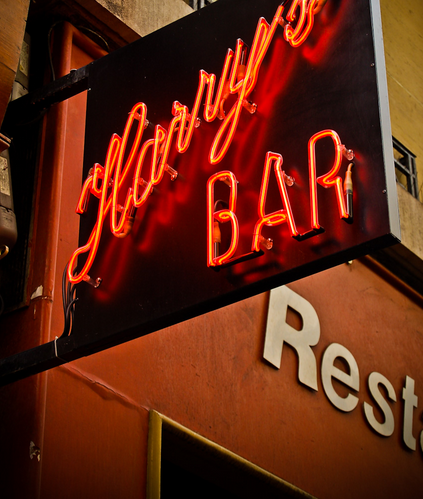Reid writes that the product life cycle is a theory that “describes how a product progresses from its infancy as a new product in development, through a growth phase, to a maturity phase, and then, eventually into decline.”
In last week’s class, we discussed the “product life cycle” of Lone Star and determined that it currently sits on the peak of the cycle, in the “mature” stage. This topic stayed with me, and I wanted to try and figure out another successful business’ positioning in the cycle. As I was browsing the Ottawa Citizen’s travel section, I came across this article:
http://www.ottawacitizen.com/story_print.html?id=5754911&sponsor=
For those of you who’d rather not read it, I’ll explain.
Harry’s New York Bar is a bar (obviously) in Paris that opened exactly 100 years ago (almost to the day).
In 1911, it was suggested to Harry MacElhone, by a US jockey, to shift his existing New York bar to Rue Daunou, in Paris, France. By “shift”, I mean completely dismantle it, move it across the ocean, and set it all up again.
Harry had taken the advice, and on the American’s Thanksgiving Day, November 26, 1911, had opened his new establishment, which eventually became the birthplace of several well-known cocktails. These include: The White Lady (1919), The Blood Mary (1921), The Side Car (1931), The Blue Lagoon (1960), and many more. His bar also became the choice watering hole of some big names, including famous author and Noble Prize winner, Ernest Hemingway (a close friend to the MacElhone family).
Famous movie icon, James Bond, deemed Harry’s the best place in Paris to get a “solid drink”, where the original “shaken not stirred” vodka martini was created.
The fame doesn’t stop there, for here we are, 100 years later, and Harry’s is still known for being “a small corner of Manhattan in the heart of Paris”.( AGENCE FRANCE-PRESSE) The bar’s current owner, Isabelle MacElhone (grand-daughter in-law to Harry), planned a centennial celebration for 300 guests and also plans to publish a book about the bar’s history in the very near future.
In the new paper’s interview, Isabelle discussed the plainness of the establishment. It’s described as having an “aged wooden bar, (with) white-aproned barmen (who can) expertly mix the driest of Martinis or pour out tumblers of single-malt Scotch”. (AGENCE FRANCE-PRESSE) The bar also doesn’t contain any televisions and plays no music, making their main focus discussion and conversation.
Isabelle is quoted by saying, “It’s not a trendy place, but this is why it will never be out of fashion.”
So, here’s the big question: How can a bar with no “extras” still be successful after 100 straight years of service?
In the city of lights, it stands as the only bar of its kind, being surrounded by stereotypical French brasseries and bistros, giving the bar a fresh look in comparison. With its undeniable fame through celebrity customers like Clint Eastwood and Humphrey Bogart and having created over 5 legendary cocktails, Harry’s has become an American “hot spot” in Paris.
My Thoughts:
Honestly, upon reading the article I was actually surprised that a bar making little or no effort to move forward with trends and style, ESPECIALLY in Paris, France, could remain open in our ever-changing society. I just couldn’t picture something that sounded so “blah” (by physical description) making it through my generation’s high demands. Even in our mixology course, the professor has owned a few bars and has told us that it’s almost impossible to survive in the bar industry for a long time because most people are looking for the next big thing.
However, Harry’s seems to be sitting proudly in its maturity stage after all this time. If it has sunk in any measure over the years, a celebration like a centennial will have definitely shot them right back up. From my understanding, this is due to its history of creating legendary drinks, serving remarkable and famous clientele and from their focus on a social atmosphere, instead of a material-based one.
I think it would be interesting to be in a city like Paris, and walk into a place so plain in décor, but with such a rich history. I would personally love to visit this bar and experience a bar scene without any music or televisions, something that before now, didn’t seem too realistic to me.
Congratulations Harry, you’ve officially gone down in history.
Cheers,
Sam

